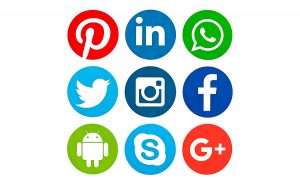Question: At the beginning of this lesson I pointed to the idea that technological advances in communication tools have been part of the impetus to rethink the divisive and hierarchical categorizing of literature and orality, and suggested that this is happening for a number of reasons. I’d like you to consider two aspects of digital literature: 1) social media tools that enable widespread publication, without publishers, and 2) Hypertext, which is the name for the text that lies beyond the text you are reading, until you click. How do you think these capabilities might be impacting literature and story?
With advancements of technology in our modern world, social media has become one of the biggest social norms. The internet has allowed for individuals from different parts of the world to share their free speech and communicate with each other through a variety of different platforms. This creation of www space has changed how literature is obtained, shared and read. The web surface has allowed for a widespread of publication without publishers, where anyone can create and share their work and other people can freely obtain the work without any restrictions. On top of that, the internet has allowed for further discussions and questions to be publicly made on the work through comments and re-posting. This further takes the readers’ greater interpretative control by allowing for creation of a space where on-going discussions, interpretations and thoughts of the work can be shared among other people and the author.
 Social media as a storytelling format has broken down some of the boundaries and built a sense of a community. As Chamberlin states “words make us feel closer to the world we live in,” (1) and social media has further made people feel connection to the world by words. Traditionally, there was only a one-way relationship between a reader and author, but now social media allows for unlimited publication and boundless sharing from many people. Platforms such as Facebook, Twitter, Instagram and Blogs allow for anyone to freely share their thoughts, opinions and join in the discussions. People are able to find and connect with those who have the same interest easily through hashtags, commonly liked pages and search engines. One can personalized what they like to see on their social media by only “following” the works they are interested in and can connect with others who have the same interest through messaging or commenting on each other’s post or comment. Showing support for someone’s work can be easily done by following the person, re-sharing their post and/or liking the post. Because internet is easily accessible and less time consuming compared to getting in touch with people offline, creation of communities on a large-scale number of people are done relatively easily and fast through constant updates and uploads done online.
Social media as a storytelling format has broken down some of the boundaries and built a sense of a community. As Chamberlin states “words make us feel closer to the world we live in,” (1) and social media has further made people feel connection to the world by words. Traditionally, there was only a one-way relationship between a reader and author, but now social media allows for unlimited publication and boundless sharing from many people. Platforms such as Facebook, Twitter, Instagram and Blogs allow for anyone to freely share their thoughts, opinions and join in the discussions. People are able to find and connect with those who have the same interest easily through hashtags, commonly liked pages and search engines. One can personalized what they like to see on their social media by only “following” the works they are interested in and can connect with others who have the same interest through messaging or commenting on each other’s post or comment. Showing support for someone’s work can be easily done by following the person, re-sharing their post and/or liking the post. Because internet is easily accessible and less time consuming compared to getting in touch with people offline, creation of communities on a large-scale number of people are done relatively easily and fast through constant updates and uploads done online.
The openness of the internet has both pros and cons. The cons are that it has led to excessive amount of literature and stories that are much more amateur and some incorrect. However, it has allowed for voices of the minority to share their stories and become successful through self-publishing, proving that they do not need approval from the publisher. People are able to access all kinds of information that are not filtered by what publisher thinks is good but pick and choose what they like themselves.

Great example of a minority voice who have found their success through self-publishing is a famous SNS poet Ha Sang Wook from Korea. He started writing short poems and posted them on Facebook and Twitter which went viral with more than fifty thousand people following his page. The reason he got so many attentions from the public was because he wrote meaningful poems in a witty tone that many readers could sympathise with by using just a few words and unique titles. His poems were very short and yet touched on the reality of the society that many young minds could emphasize with. His poems were one of those poems that were very short, sometimes only having two lines but leaves you with a huge impact and makes you think about it again. An author like him has truly benefited from the fast culture nowadays and made people feel close to the world by words.
Hyperlink is another feature of the digital literature that allows for greater connectivity. Compared to the non-web based text, web contents frequently include hyperlinks that allow for readers to extend their understanding of the literature. Hyperlinks are often placed where the writers want to highlight the information to the reader, but it is always up to the reader’s control whether or not they decide to click on the link and read it. According to a study by Fitzsimmons, although some researchers have claimed that hyperlinks hinder reading because they are a distraction, the study proves that hyperlink does not have a negative effect on the reader’s ability to process the text but rather makes it easier for readers to understand difficult information through hyperlinks.
Works Cited
Chamberlin, J. Edward. “A New History of Reading: Hunting, Tracking, and Reading.” For the Geography of a Soul: Emerging Perspectives on Kamau Braithwaite. Ed. Timothy J. Reiss., 145-164. Trenton: Africa World Press, 2001. 145-164.
Choi, Yoon Ji “Ha Sang Wook, A Poet Who Draws Empathy through SNS.” The Granite Tower, www.thegranitetower.com/news/articleView.html?idxno=802.
Fitzsimmons, Gemma, et al. “On Measuring the Impact of Hyperlinks on Reading.” Proceedings of the 5th Annual ACM Web Science Conference on – WebSci 13, 2013, doi:10.1145/2464464.2464501.